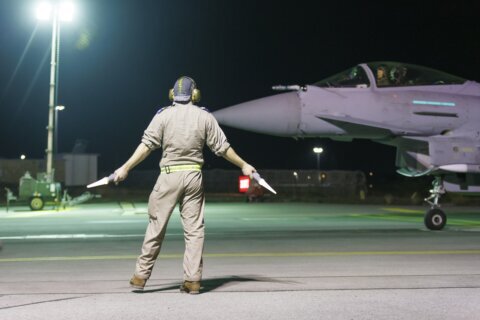For an undetermined period of time, as a 200-foot balloon from China drifted into U.S. air space earlier this month, military pilots were keeping a close eye on it.
According to a U.S. government official, information gathered from their missions revealed the balloon was likely dispatched by the Chinese government as a tool to conduct spying operations, apparently inside the U.S.
“We know the People’s Republic of China used these balloons for surveillance. High-resolution imagery from U-2 flybys revealed that the high-altitude balloon was capable of conducting signals intelligence collection operations,” a State Department spokesperson said in a statement.
The balloon’s equipment, the spokesperson said, “was clearly for intelligence surveillance and inconsistent with the equipment onboard weather balloons.”
On the other hand, the Chinese government said the balloon — initially spotted over Billings, Montana — was designed to collect weather-related information.
But the State Department spokesperson said, “It had multiple antennas, to include an array likely capable of collecting and geolocating communications. It was equipped with solar panels large enough to produce the requisite power to operate multiple active intelligence collection sensors.”
Acutely aware of what the balloon was capable of, the Pentagon watched closely as it wafted across the country.
“Clearly, as we saw this balloon come into U.S. airspace, we tracked it very closely. As it went over the continental U.S., we started developing options on how best to take it down once it was safe to do so, and we did that once it got over water,” said Brig. Gen. Pat Ryder, Pentagon press secretary.
But complaints about the strategy to let it traverse the entire country grew louder during the four days it floated on a southeasterly path, before being shot down on Feb. 4.
Numerous politicians complained that it should’ve been shot down immediately. But the Biden administration and military leaders agreed shooting it down over water was the best option to avoid possibly causing harm to people on the ground.
But there was another reason.
“The important thing to remember here, too, is that this was an opportunity for us to learn a lot more about the PRC’s balloon surveillance program. It will all be very helpful information as we continue to track capabilities around the globe and be able to detect and respond appropriately,” Ryder said.
What the U.S. already knew about China’s spy balloons
As the saga continues to unfold, pieces of debris from the balloon and payload, collected by the FBI, are undergoing meticulous examination at their Quantico forensics facility. They have not revealed any details about what they’ve learned.
The State Department, however, seems to know quite a bit.
“We know these balloons are all part of a PRC fleet of balloons developed to conduct surveillance operations. These kinds of activities are often undertaken at the direction of the People’s Liberation Army,” said the State Department spokesperson.
The spokesperson also said the balloon manufacturer has a direct relationship with China’s military and is an approved vendor of the PLA, according to information published in an official procurement portal for the PLA.
Having some knowledge about the capabilities of this balloon, damage control was an immediate concern for the Pentagon.
“We took steps very quickly to mitigate any potential collection activities that this balloon would be doing as it traversed the U.S.,” Ryder said.
Declining to discuss specific details about those actions taken, he indicated the Pentagon may have had access to some historical data about balloons like this one.
“Based on our flight models and our ability to predict what its track was going to be, we were able to take appropriate steps.”
While much of the Pentagon’s intelligence about the balloon is classified, the State Department spokesperson indicated the company that produced the balloon had posted some revealing information.
“The company,” the spokesperson said “also advertises balloon products on its website and hosts videos from past flights, which appear to have overflown at least U.S. airspace and airspace of other countries. These advertised balloon videos seemingly have similar flight patterns as the balloons we have been discussing this week.”
The discussions won’t likely end anytime soon, nor will the scrutiny of Beijing.
The Defense Intelligence Agency is aggressively standing up a project to address what its director, Lt. Gen. Scott Berrier, calls the “China problem set.”
He said during a recent interview, “We’re going to do what President Obama told us to do in 2013 when he said pivot to the Pacific. We are in that mode right now.”
In doing so, he said they are organizing a team called the China Mission Group.
“These are hundreds of analysts that are focused on the China problem set, to include collectors, mission managers, requirements managers — all focused on this problem set.”
The State Department hinted there may be sanctions coming against Chinese entities involved in the building and operation of the balloon, which violated international law by entering U.S. airspace without permission.
And there will be more political scrutiny as well.
“The Senate Intelligence Committee deserves more answers from intelligence officials about what happened here,” Sen. Mark Warner said in a statement.
“I understand the arguments about safety and potential vulnerabilities,” Warner said, “but I would like to know more about any additional actions we could have or should have taken in response to this incident.”
Warner also said, “We need to learn more about how we communicate with our adversaries in the event of a potential crisis. We have long-established protocols with Russia, for example, but we don’t have the same level of protocols with China.”
Chinese military officials refused to speak with Secretary of Defense Lloyd Austin after the balloon was shot down.
“We need to make sure that there is a game plan for these incidents as opposed to an ad hoc reaction,” Warner said.








